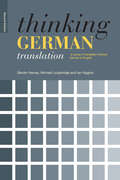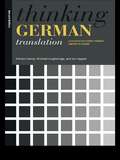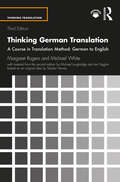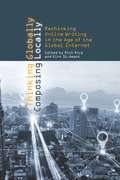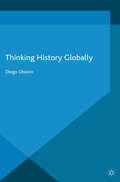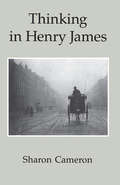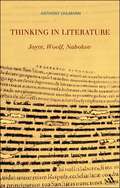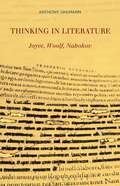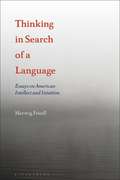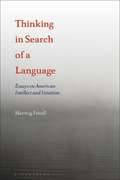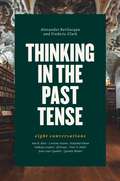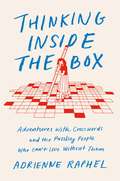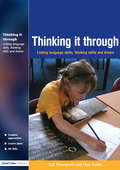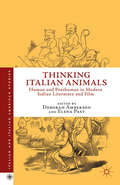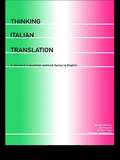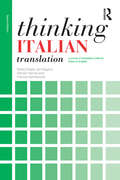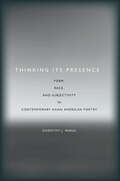- Table View
- List View
Thinking German Translation: A Course In Translation Method: German To English (Thinking Translation)
by Ian Higgins Sandor Hervey Michael LoughridgeThis is a comprehensive practical course in translation for advanced students of German, which focuses on improving translation quality whilst clarifying the theoretical issues involved. This second edition brings the course up-to-date, and has been fully reworked to give clearer explanations of key terms and include revised chapters on genre, compensation and revision and editing. Based on detailed analysis of translation problems, Thinking German Translation features new material taken from a wide range of sources, including: business and politics press and publicity engineering tourism literary and consumer-oriented texts. Addressing a variety of translation issues such as cultural difference, register and dialect, Thinking German Translation is essential reading for all students wishing to perfect their translation skills. It is also an excellent foundation for those considering a career in translation. Further resources, including a free teacher's handbook for the course, are available on the companion website at http://cw.routledge.com/textbooks/0415341469/resources/default.asp
Thinking German Translation: A Course in Translation Method (Thinking Translation)
by Ian Higgins Sándor Hervey Michael Loughridge Mr Ian HigginsThinking German Translation is a comprehensive and revolutionary 20-week course in translation method offering a challenging and entertaining approach to the acquisition of translation skills. It has been fully and successfully piloted at the University of St.Andrews.Translation is presented as a problem-solving discipline. Discussion, examples and a full range of exercise work enable students to acquire the skills necessary for a broad range of translation problems.Examples are drawn from a wide variety of material from technical and commercial texts to poetry and song.Thinking German Translation is essential reading for advanced undergraduates and postgraduate students of German. The book will also appeal to a wide range of languages students and tutors through the general discussion of principles, purposes and practice of translation.
Thinking German Translation: A Course in Translation Method: German to English (Thinking Translation)
by Margaret Rogers Michael White Michael Loughridge Ian Higgins Sándor HerveyThinking German Translation is a comprehensive practical course in translation for advanced undergraduate students of German and postgraduate students embarking on Master’s translation programmes. Now in its third edition, this course focuses on translation as a decision-making process, covering all stages of the translation process from research, to the ‘rewriting’ of the source text in the language of translation, to the final revision process. This third edition brings the course up to date, referencing relevant research sources in Translation Studies and technological developments as appropriate, and balancing the coverage of subject matter with examples and varied exercises in a wide range of genres from both literary and specialised material. All chapters from the second edition have been extensively revised and, in many cases, restructured; new chapters have been added—literary translation; research and resources—as well as suggestions for further reading. Offering around 50 practical exercises, the course features material from a wide range of sources, including: business, economics and politics advertising, marketing and consumer texts tourism science and engineering modern literary texts and popular song the literary canon, including poetry A variety of translation issues are addressed, among them cultural differences, genre conventions, the difficult concept of equivalence, as well as some of the key differences between English and German linguistic and textual features. Thinking German Translation is essential reading for all students seriously interested in improving their translation skills. It is also an excellent foundation for those considering a career in translation. A Tutor’s Handbook offers comments and notes on the exercises for each chapter, including not only translations but also a range of other tasks, as well as some specimen answers. It is available to download from www.routledge.com/9781138920989.
Thinking Globally, Composing Locally: Rethinking Online Writing in the Age of the Global Internet
by Rich RiceThinking Globally, Composing Locally explores how writing and its pedagogy should adapt to the ever-expanding environment of international online communication. Communication to a global audience presents a number of new challenges; writers seeking to connect with individuals from many different cultures must rethink their concept of audience. They must also prepare to address friction that may arise from cross-cultural rhetorical situations, variation in available technology and in access between interlocutors, and disparate legal environments. The volume offers a pedagogical framework that addresses three interconnected and overarching objectives: using online media to contact audiences from other cultures to share ideas; presenting ideas in a manner that invites audiences from other cultures to recognize, understand, and convey or act upon them; and composing ideas to connect with global audiences to engage in ongoing and meaningful exchanges via online media. Chapters explore a diverse range of pedagogical techniques, including digital notebooks designed to create a space for active dialogic and multicultural inquiry, experience mapping to identify communication disruption points in international customer service, and online forums used in global distance education. Thinking Globally, Composing Locally will prove an invaluable resource for instructors seeking to address the many exigencies of online writing situations in global environments. Contributors: Suzanne Blum Malley, Katherine Bridgman, Maury Elizabeth Brown, Kaitlin Clinnin, Cynthia Davidson, Susan Delagrange, Scott Lloyd Dewitt, Amber Engelson, Kay Halasek, Lavinia Hirsu, Daniel Hocutt, Vassiliki Kourbani, Tika Lamsal, Liz Lane, Ben Lauren, J. C. Lee, Ben McCorkle, Jen Michaels, Minh-Tam Nguyen, Beau S. Pihlaja, Mª Pilar Milagros, Cynthia L. Selfe, Heather Turner, Don Unger, Josephine Walwema
Thinking History Globally
by Diego OlsteinThe book brings together many recent trends in writing history under a common framework: thinking history globally. By thinking history globally, the book explains, applies, and exemplifies the four basic strategies of analysis, the big C's: comparing, connecting, conceptualizing, and contextualizing, using twelve different branches of history.
Thinking in Henry James (The\other Voice In Early Modern Europe Ser.)
by Sharon CameronThinking in Henry James identifies what is genuinely strange and radical about James's concept of consciousness—first, the idea that it may not always be situated within this or that person but rather exists outside or "between," in some transpersonal place; and second, the idea that consciousness may have power over things and people outside the person who thinks. Examining these and other counterintuitive representations of consciousness, Cameron asks, "How do we make sense of these conceptions of thinking?"
Thinking in Literature: Joyce, Woolf, Nabokov
by Anthony UhlmannThinking in Literature examines how the Modernist novel might be understood as a machine for thinking, and how it offers means of coming to terms with what it means to think. It begins with a theoretical analysis, via Deleuze, Spinoza and Leibniz, of the concept of thinking in literature, and sets out three principle elements which continually announce themselves as crucial to the process of developing an aesthetic expression: relation; sensation; and composition. Uhlmann then examines the aesthetic practice of three major Modernist writers: James Joyce, Virginia Woolf, and Vladimir Nabokov. Each can be understood as working with relation, sensation and composition, yet each emphasize the interrelations between them in differing ways in expressing the potentials for thinking in literature.
Thinking in Literature: Joyce, Woolf, Nabokov
by Anthony UhlmannThinking in Literature examines how the Modernist novel might be understood as a machine for thinking, and how it offers means of coming to terms with what it means to think. It begins with a theoretical analysis, via Deleuze, Spinoza and Leibniz, of the concept of thinking in literature, and sets out three principle elements which continually announce themselves as crucial to the process of developing an aesthetic expression: relation; sensation; and composition. Uhlmann then examines the aesthetic practice of three major Modernist writers: James Joyce, Virginia Woolf, and Vladimir Nabokov. Each can be understood as working with relation, sensation and composition, yet each emphasize the interrelations between them in differing ways in expressing the potentials for thinking in literature.
Thinking in Search of a Language: Essays on American Intellect and Intuition
by Herwig FriedlThinking in Search of a Language explores American literary and philosophical traditions, and their intimate connections, by focusing on two defining strands in the intellectual history of the United States. The first half of the book offers a multifaceted interpretation of Emerson's constantly shifting early-modernist thought-“I liked everything by turns and nothing long,” he said memorably-and its legacy in American writing. The second half turns to the modernists themselves and the pluralistic and radical-empiricist ways in which they engaged the world philosophically. Herwig Friedl's broad and deep examination of American thought, which also incorporates the international context and response, illuminates the global significance of the American intellectual tradition. Tying together all of these essays is the persistent question and problem of an adequate language or terminological framework as one kind of interpretive leitmotif. This reflects the fact that Friedl's sensibility is steeped in a cross-pollination of continental and American thought, a combination that recalls-and is as revelatory as-the work of Stanley Cavell.
Thinking in Search of a Language: Essays on American Intellect and Intuition
by Herwig FriedlThinking in Search of a Language explores American literary and philosophical traditions, and their intimate connections, by focusing on two defining strands in the intellectual history of the United States. The first half of the book offers a multifaceted interpretation of Emerson's constantly shifting early-modernist thought-“I liked everything by turns and nothing long,” he said memorably-and its legacy in American writing. The second half turns to the modernists themselves and the pluralistic and radical-empiricist ways in which they engaged the world philosophically. Herwig Friedl's broad and deep examination of American thought, which also incorporates the international context and response, illuminates the global significance of the American intellectual tradition. Tying together all of these essays is the persistent question and problem of an adequate language or terminological framework as one kind of interpretive leitmotif. This reflects the fact that Friedl's sensibility is steeped in a cross-pollination of continental and American thought, a combination that recalls-and is as revelatory as-the work of Stanley Cavell.
Thinking in the Past Tense: Eight Conversations
by Alexander Bevilacqua Frederic ClarkIf the vibrancy on display in Thinking in the Past Tense is any indication, the study of intellectual history is enjoying an unusually fertile period in both Europe and North America. This collection of conversations with leading scholars brims with insights from such diverse fields as the history of science, the reception of classical antiquity, book history, global philology, and the study of material culture. The eight practitioners interviewed here specialize in the study of the early modern period (c. 1400–1800), for the last forty years a crucial laboratory for testing new methods in intellectual history. The lively conversations don’t simply reveal these scholars’ depth and breadth of thought; they also disclose the kind of trade secrets that historians rarely elucidate in print. Thinking in the Past Tense offers students and professionals alike a rare tactile understanding of the practice of intellectual history. Here is a collectively drawn portrait of the historian’s craft today.
Thinking in the Past Tense: Eight Conversations
by Alexander Bevilacqua Frederic ClarkIf the vibrancy on display in Thinking in the Past Tense is any indication, the study of intellectual history is enjoying an unusually fertile period in both Europe and North America. This collection of conversations with leading scholars brims with insights from such diverse fields as the history of science, the reception of classical antiquity, book history, global philology, and the study of material culture. The eight practitioners interviewed here specialize in the study of the early modern period (c. 1400–1800), for the last forty years a crucial laboratory for testing new methods in intellectual history. The lively conversations don’t simply reveal these scholars’ depth and breadth of thought; they also disclose the kind of trade secrets that historians rarely elucidate in print. Thinking in the Past Tense offers students and professionals alike a rare tactile understanding of the practice of intellectual history. Here is a collectively drawn portrait of the historian’s craft today.
Thinking in the Past Tense: Eight Conversations
by Alexander Bevilacqua Frederic ClarkIf the vibrancy on display in Thinking in the Past Tense is any indication, the study of intellectual history is enjoying an unusually fertile period in both Europe and North America. This collection of conversations with leading scholars brims with insights from such diverse fields as the history of science, the reception of classical antiquity, book history, global philology, and the study of material culture. The eight practitioners interviewed here specialize in the study of the early modern period (c. 1400–1800), for the last forty years a crucial laboratory for testing new methods in intellectual history. The lively conversations don’t simply reveal these scholars’ depth and breadth of thought; they also disclose the kind of trade secrets that historians rarely elucidate in print. Thinking in the Past Tense offers students and professionals alike a rare tactile understanding of the practice of intellectual history. Here is a collectively drawn portrait of the historian’s craft today.
Thinking in the Past Tense: Eight Conversations
by Alexander Bevilacqua Frederic ClarkIf the vibrancy on display in Thinking in the Past Tense is any indication, the study of intellectual history is enjoying an unusually fertile period in both Europe and North America. This collection of conversations with leading scholars brims with insights from such diverse fields as the history of science, the reception of classical antiquity, book history, global philology, and the study of material culture. The eight practitioners interviewed here specialize in the study of the early modern period (c. 1400–1800), for the last forty years a crucial laboratory for testing new methods in intellectual history. The lively conversations don’t simply reveal these scholars’ depth and breadth of thought; they also disclose the kind of trade secrets that historians rarely elucidate in print. Thinking in the Past Tense offers students and professionals alike a rare tactile understanding of the practice of intellectual history. Here is a collectively drawn portrait of the historian’s craft today.
Thinking in the Past Tense: Eight Conversations
by Alexander Bevilacqua Frederic ClarkIf the vibrancy on display in Thinking in the Past Tense is any indication, the study of intellectual history is enjoying an unusually fertile period in both Europe and North America. This collection of conversations with leading scholars brims with insights from such diverse fields as the history of science, the reception of classical antiquity, book history, global philology, and the study of material culture. The eight practitioners interviewed here specialize in the study of the early modern period (c. 1400–1800), for the last forty years a crucial laboratory for testing new methods in intellectual history. The lively conversations don’t simply reveal these scholars’ depth and breadth of thought; they also disclose the kind of trade secrets that historians rarely elucidate in print. Thinking in the Past Tense offers students and professionals alike a rare tactile understanding of the practice of intellectual history. Here is a collectively drawn portrait of the historian’s craft today.
Thinking in the Past Tense: Eight Conversations
by Alexander Bevilacqua Frederic ClarkIf the vibrancy on display in Thinking in the Past Tense is any indication, the study of intellectual history is enjoying an unusually fertile period in both Europe and North America. This collection of conversations with leading scholars brims with insights from such diverse fields as the history of science, the reception of classical antiquity, book history, global philology, and the study of material culture. The eight practitioners interviewed here specialize in the study of the early modern period (c. 1400–1800), for the last forty years a crucial laboratory for testing new methods in intellectual history. The lively conversations don’t simply reveal these scholars’ depth and breadth of thought; they also disclose the kind of trade secrets that historians rarely elucidate in print. Thinking in the Past Tense offers students and professionals alike a rare tactile understanding of the practice of intellectual history. Here is a collectively drawn portrait of the historian’s craft today.
Thinking Inside the Box: Adventures with Crosswords and the Puzzling People Who Can't Live Without Them
by Adrienne Raphel'Beautifully researched account, full of humour and personal insight'David Crystal, author of Making Sense: The Glamorous Story of English Grammar'A witty, wise, and wonderfully weird journey that will change the way you think . . . This book is a delight'Bianca Bosker, author of Cork Dork: A Wine-Fueled Adventure Among the Obsessive Sommeliers, Big Bottle Hunters, and Rogue Scientists Who Taught Me to Live for Taste'Delightfully engrossing, charmingly and enthusiastically well-written history of the crossword puzzle' Benjamin Dreyer, author of Dreyer's English: An Utterly Correct Guide to Clarity and Style 'Full of treasures, surprises and fun . . . richly bringing to life the quirky, obsessive, fascinating characters in the crossword world' Mary Pilon, author of The Monopolists: Obsession, Fury, and the Scandal Behind the World's Favorite Board Game 'A gold mine of revelations. If there is a pantheon of cruciverbalist scholars, Adrienne Raphel has established herself squarely within it'Mary Norris, author of Between You & Me: Confessions of a Comma QueenEqual parts ingenious and fun, Thinking Inside the Box is a love letter to the infinite joys and playful possibilities of language, a treat for die-hard cruciverbalists and first-time crossword solvers alike.The crossword is a feature of the modern world, inspiring daily devotion and obsession from millions. It was invented in 1913, almost by accident, when an editor at the New York World was casting around for something to fill some empty column space for that year's Christmas edition. Almost overnight, crosswords became a phenomenal commercial success, and have been an essential ingredient of any newspaper worth its salt since then. Indeed, paradoxically, the popularity of crosswords has never been greater, even as the world of media and newspapers, the crossword's natural habitat, has undergone a dramatic digital transformation. But why, exactly, are the satisfactions of a crossword so sweet that over the decades they have become a fixture of breakfast tables, bedside tables and commutes, and even given rise to competitive crossword tournaments?Blending first-person reporting from the world of crosswords with a delightful telling of the crossword's rich literary history, Adrienne Raphel dives into the secrets of this classic pastime. At the annual American Crossword Puzzle Tournament, she rubs shoulders with elite solvers from all over the world, doing her level best to hold her own; aboard a crossword-themed cruise she picks the brains of the enthusiasts whose idea of a good time is a week on the high seas with nothing to do but crosswords; and, visiting the home and office of Will Shortz, New York Times crossword puzzle editor and US National Public Radio's official Puzzlemaster, she goes behind the scenes to see for herself how the world's gold standard of puzzles is made.
Thinking it Through: Developing Thinking and Language Skills Through Drama Activities
by Gill Thompson Huw EvansTeaching should be exciting and creative but an overcrowded curriculum can make this hard for teachers to achieve. Help is at hand with these literacy and numeracy lesson plans that also cover language development, thinking skills, and drama. Thinking it Through allows teachers to customize lesson plans to meet their own needs using the book's accompanying CD as well as assess pupils language abilty with handy photocopiable assessment worksheets. The book will help each child reach their full potential regardless of ability using ideas for differentiation and extension and structure lessons according to national curriculum objectives.
Thinking it Through: Developing Thinking and Language Skills Through Drama Activities
by Gill Thompson Huw EvansTeaching should be exciting and creative but an overcrowded curriculum can make this hard for teachers to achieve. Help is at hand with these literacy and numeracy lesson plans that also cover language development, thinking skills, and drama. Thinking it Through allows teachers to customize lesson plans to meet their own needs using the book's accompanying CD as well as assess pupils language abilty with handy photocopiable assessment worksheets. The book will help each child reach their full potential regardless of ability using ideas for differentiation and extension and structure lessons according to national curriculum objectives.
Thinking Italian Animals: Human and Posthuman in Modern Italian Literature and Film (Italian and Italian American Studies)
by Deborah Amberson Elena PastThis bracing volume collects work on Italian writers and filmmakers that engage with nonhuman animal subjectivity. These contributions address 3 major strands of philosophical thought: perceived borders between man and animals, historical and fictional crises, and human entanglement with the nonhuman and material world.
Thinking Italian Translation: Italian to English
by Stella Cragie Ian Higgins Sándor Hervey Patrizia GambarottaThinking Italian Translation is a comprehensive and practical translation course. It focuses on improving translation quality and gives clear definitions of translation theories. Texts are taken from sources including journalism, technical texts and screenplays. Translation issues addressed include cultural differences, genre, and revision and editing.Adapted from the successful French-based Thinking Translation (1992), the course has been piloted and refined at the Universities of St Andrews and Glasgow. A Tutor's Handbook is available, which contains invaluable guidance on using the course.
Thinking Italian Translation: A course in translation method: Italian to English (Thinking Translation)
by Stella Cragie Ian Higgins Sándor Hervey Patrizia GambarottaThinking Italian Translation is an indispensable course for students who want to develop their Italian to English translation skills. This new edition includes: up-to-date examples and new source texts from a variety of genres, from journalistic to technical. a brand new section on professionalism and the translation market The course is practical, addressing key issues for translators such as cultural differences, genre, and revision and editing. At the same time, it clearly defines translation theories. Thinking Italian Translation is key reading for advanced students wishing to perfect their language skills or considering a career in translation.
Thinking Italian Translation: A Course in Translation Method: Italian to English (Thinking Translation)
by Stella Cragie Ian Higgins Sándor Hervey Patrizia GambarottaThinking Italian Translation is a comprehensive and practical translation course. It focuses on improving translation quality and gives clear definitions of translation theories. Texts are taken from sources including journalism, technical texts and screenplays. Translation issues addressed include cultural differences, genre, and revision and editing.Adapted from the successful French-based Thinking Translation (1992), the course has been piloted and refined at the Universities of St Andrews and Glasgow. A Tutor's Handbook is available, which contains invaluable guidance on using the course.
Thinking Italian Translation: A course in translation method: Italian to English (Thinking Translation)
by Stella Cragie Ian Higgins Sándor Hervey Patrizia GambarottaThinking Italian Translation is an indispensable course for students who want to develop their Italian to English translation skills. This new edition includes: up-to-date examples and new source texts from a variety of genres, from journalistic to technical. a brand new section on professionalism and the translation market The course is practical, addressing key issues for translators such as cultural differences, genre, and revision and editing. At the same time, it clearly defines translation theories. Thinking Italian Translation is key reading for advanced students wishing to perfect their language skills or considering a career in translation.
Thinking Its Presence: Form, Race, and Subjectivity in Contemporary Asian American Poetry (Asian America #74)
by Dorothy J. WangWhen will American poetry and poetics stop viewing poetry by racialized persons as a secondary subject within the field? Dorothy J. Wang makes an impassioned case that now is the time. Thinking Its Presence calls for a radical rethinking of how American poetry is being read today, offering its own reading as a roadmap. While focusing on the work of five contemporary Asian American poets—Li-Young Lee, Marilyn Chin, John Yau, Mei-mei Berssenbrugge, and Pamela Lu—the book contends that aesthetic forms are inseparable from social, political, and historical contexts in the writing and reception of all poetry. Wang questions the tendency of critics and academics alike to occlude the role of race in their discussions of the American poetic tradition and casts a harsh light on the double standard they apply in reading poems by poets who are racial minorities. This is the first sustained study of the formal properties in Asian American poetry across a range of aesthetic styles, from traditional lyric to avant-garde. Wang argues with conviction that critics should read minority poetry with the same attention to language and form that they bring to their analyses of writing by white poets.
